Hawaii bellwether Hawaiian Airlines announced today that it’s agreed to invest in a next generation 100-person capacity all-electric seaglider known as the Regent Monarch. Read on for questions we are having about this.
See a memorizing video below of the amazing hybrid ferry/aircraft that’s set to start commercial deliveries in 2028. The hybrid plane/boat is capable of Hawaii harbor-to-harbor service, and could be an ideal replacement for the failed Hawaii Superferry.
“Once airborne, the seaglider rises only a short distance above the surface of the water using a phenomenon known in aviation as the “ground effect”: When a descending airplane is close to land or water, the air and pressure distortions between the wings and the surface create lift. It’s why an airliner appears to float just before landing. “It’s this cushion of air flying over the surface of the water.” That according to the manufacturer. The Seagliders maneuver within harbors like a boat. Once in open water, they rise to operate more like a plane.
Mokulele Airlines parent places SeaGlider order.
While Hawaiian is the manufacturer’s first U.S. development partner, it isn’t the first airline with Hawaii roots that plans to take to the water. Mokulele’s parent, Southern Airways Express, became a customer for Regent seagliders last December. That little-reported $250 million purchase was for 15 of Regent’s small 12-passenger Viceroy’s, and 5 of the latest 100-seat Monarchs that Hawaiian is interested in. Regent indicated that the Mokulele-parent deal was greatly discounted, having an actual value of more than $600 million. A number of other airlines have signed on to Regent Seagliders before today’s Hawaiian announcement. While SAE didn’t specifically mention Hawaii flights, that is a no brainer.
The plan is to provide Hawaii with interisland transportation at a fraction of the cost, noise, and emissions of existing interisland flights.
“Innovative interisland transportation has been core to our business since 1929 when we replaced steam ships with airplanes. We are excited to be an early investor in REGENT and to be involved in developing their largest seaglider – a vehicle with great potential for Hawaii’,” said Avi Mannis, Chief Marketing and Communications Officer at Hawaiian Airlines. “We look forward to working with REGENT to explore the technology and infrastructure needed to fulfill our vision for convenient, comfortable and environmentally sustainable interisland transportation.”
Regent added, “Seagliders will be a game-changer for sustainable regional transportation in communities such as Hawaii.
Seagliders – what are they?
These seagliders are all-electric, “wing-in-ground-effect” vehicles which travel within a wingspan of the ocean’s surface and have the speed of an airplane (200 mph) with the operating cost of a boat. They are built to the same safety specifications as modern aircraft and watercraft. These are capable of serving on routes typical of Hawaii interisland, up to 180 miles with current battery technology and later up to 500 miles with next-gen batteries.
BOH: Now this could be a very popular and unique way to travel in Hawaii, and at the same time get an ocean travel experience you don’t get on a plane. There are a lot of questions too, including whether these are TSA secured flights, or are these considered boat travel. The good news is that travel times would be very close to the current experience, unlike the SuperFerry, which took hours. Also, there would need to be car rentals available, which was an issue with SuperFerry. Are these safe for Hawaii’s wildlife including humpback whales?
History of Failed Hawaii Ferry Ventures
Did you know that before the Hawaii Superferry, interisland ferry service started similar to the Regent plan? That began in 1975. It was based on the Boeing 929 Jetfoil boat named Kamehameha, pictured below. What was initially intended to transport visitors from Honolulu Airport to Waikiki, became interisland service.
A Hawaii ferry system has always been a dream for air transportation-reliant Hawaii.
Hawaii Ferry – SeaFlite
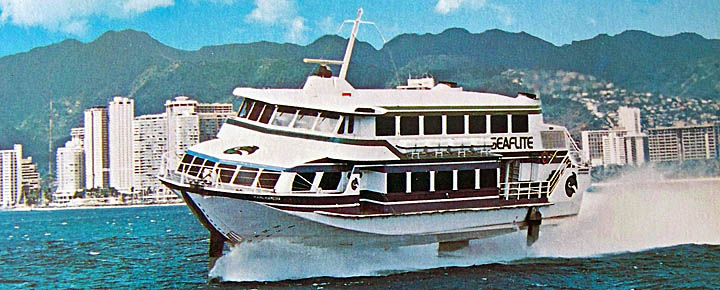

The SeaFlite service ran for just under three years, using three boats. It ended largely due to financial problems and the boats were later used in Hong Kong. At the time, the service ran up to 12 times daily and cost a whopping $20 each way.
Seasickness presented a severe problem on the boats.
At the time, these were supposed to be smooth riding, since they skimmed just above the waves. That turned out to not be the case however. There was also a fire on one of the boats, as well as a collision with a Coast Guard boat. The 929 turned out to not be reliable and cancellations were frequent. There were concerns about Hawaiian humpback whale collisions as well, although we are not aware of any that actually happened.
Hawaii Superferry
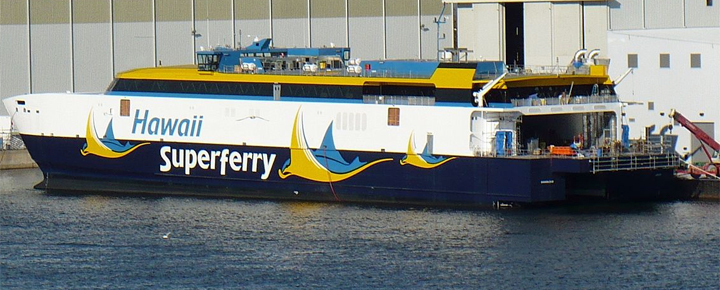

The Hawaii Superferry, the most recent Hawaii ferry attempt, started in 2007 and was operational a mere 18 months. These aluminum catamarans were drive-on, drive-off, designed for military use, and could carry up to 866 passengers plus 282 cars. Issues included a lack of environmental impact studies, enormous fuel consumption due to size and weight, and ongoing seasickness problems.
“We’re focused on the maritime market, on coastal mobility,” said Thalheimer. “And that’s important [because] 40% of the world’s population lives in coastal communities.” He said Miami to Key West, Florida, would be a one-hour flight.
A full-scale prototype will be ready next year, and the company expects the first commercial product to be available in 2025, according to Thalheimer. “We’re developing a fundamentally new mode of transportation,” he said. “To change regional mobility, we need to go green, we need to go fast and we need to innovate.”
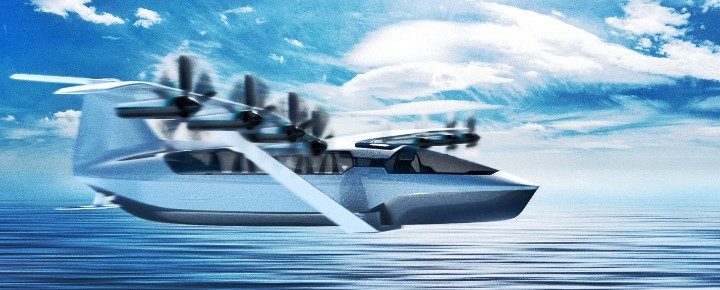
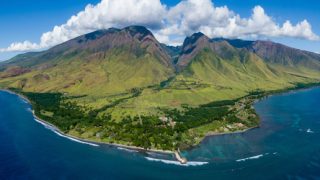
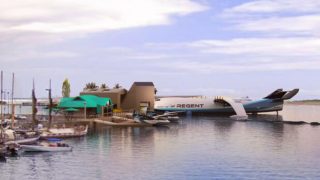
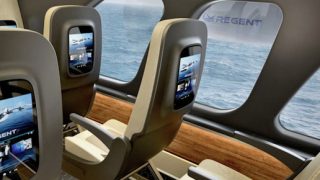
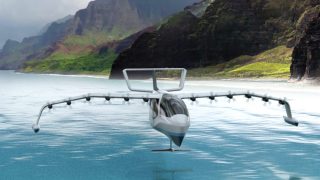
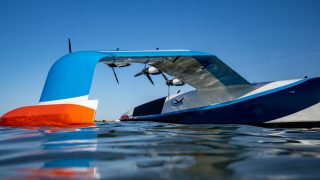
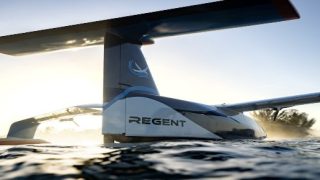
Flying just above the waves at 180 MPH is all fun and games until a humpback whale breaches in front of you. The plane maker Regentcraft.com has great videos of these flying low and fast.
Great article and news!
Awesome job. Much mahalo.
What happens if a whale breaches in the path of the vehicle?
Hows this possible it is still a plane still noisy
It’s electric. Quiet motors.
Rob,
Is that an assumption or a fact? And, will the large engines be noisy even if electric?
Don’t get me wrong – noise doesn’t bother me and if it were noisy, wouldn’t that be a wash vs 737?
I’m very interested in this concept. I just don’t see it being any cheaper than current jets or the former Ferries. Wouldn’t it be something if we could eventually fly from the Mainland to Hawaii and beyond? Maybe there will be electric refueling aircraft flying the friendly skies!
Rod W., I’m just going with what BOH wrote in the article above- “These seagliders are all-electric, “wing-in-ground-effect” vehicles”. Concerning flying electric from the mainland to Hawaii and beyond, maybe our administration will plave recharging stations on floating runways every 400 miles across the pacific, taking a full day to recharge.
Rob L.
Funny stuff.
I’m a half-glass-empty kind of guy. So, I suggest potential problems rather than getting all giddy.
But, I would love to see electric aircraft. And, they may work best over “short” with over-the-water flights.
Also, we really need to determine how “clean” electric is.
How can you even begin to compare this to the superferry. The superferry was the most versital interisland transport system Hawaii ever had until our sellout politicians killed it. This boat plane is a joke no better than what they offer already, just using different landing area notably a harbor big whoop . I dont see the bennefit
The video shows smooth waters. Hawaii doesn’t actually have much of that all the time. How will choppy waters or high surf affect the ride¿
I’m still “memorized” by the video…
Flying between the islands will mean encountering very heavy crosswinds. Since these planes depend so much on the air cushion between the plane and the ocean, I wonder what effect very heavy 30 to 40 mph winds will have on that air cushion.
Will it make the air cushion ineffective? or and will it make the ride very bumpy? Instead of seasickness there may be serious air sickness.
Your article said what I was already thinking….. what about marine mammals? Winter in HAwaii is my favorite for the Humpbacks. I would be concerned about them. I know the propellers aren’t in the water w/these seagliders, but I have sure seen what boat strikes do to countless manatees. I will have to learn more to decide what I think on these sea gliders.
With all the light weight composites used in a plane like this, if the Seaglider hits a humpback, then the whale, the plane and all the people on board are going to die. And lets not forget that out in that big ocean there are small boats, including sailboats with tall wood masts, that cannot be seen on radar, therefore at 200mph (or kts), there is not enough time to avoid a deadly collision.
Mahalo for an interesting article.
These ‘aircraft’ are known as ‘Erkanoplan’, and were developed in the USSR. The most famous is the ‘Caspian Sea Monster’ youtube.com/watch?v=V8Nu94khHoo a weaponized prototype, that tturned out to not have a misson. Very interesting craft, and several smaller versions have been built and ‘flown’ by ventures and homebuilders.
I find the concept for interisland travel very interesting, but I have my doubts as to the ambitous timeframe. When and if ever they fly, I will be one of the first in line for a ticket!
Hi George.
Good to hear from you. Thanks for sharing that.
Aloha.
To the fear of hitting a breaching whale;
A Wing In Ground Effect craft optimum altitude is one-half the total wingspan. It’s highly unlikely that w whale could get high enough to breach into the path.
Humpbacks can breach 50 feet out of the water. One half the wingspan is measured from the wing, not the bottom of the fuselage. So unless the Seaglider flies at least 100 feet above the water and more likely 150 feet- I doubt Hawaii’s strict marine laws would allow anything lower- at which altitude it would lose its ground effect, this concept won’t fly, excuse the pun.
Interesting. It might need some old/new infrastructure since they won’t be landing at existing airports. Okay, Honolulu does kind of stick out into the ocean, but maybe reactivate some of the old seaplane landings.
George,
I watched that video. To my untrained eye, it looked like jet engines, while the plane HA plans to use is a prop job.
I’d like to fly on one, but I doubt they will save the planet. And, by 2028, the price will probably not make sense.
Hope you get to make that first flight!
BOH, Good point about breaching humpbacks. If one of these jobbies hits a breaching whale, it would not only kill the whale but destroy the plane/boat, possibly kill passengers. Or….. do humpbacks breach in only certain areas, like ten miles from shore? Or do they also breach in the open ocean? Maybe you or one of our smart subscribers has an answer.
outstanding, just what hawaii needs and with minimal environmental impact. i would go interisland just for the ride alone. will it service kauai?
Looks like a fun and safer way to travel.
Hope it is successful!
Mesmerizing! Can’t wait to read this article, only have time to scan right now, thank you!
Lanell
Hi Lanell.
Thanks. Glad you had time to comment.
Aloha.
How will they avoid breaking or fluking whales?
I meant breaching whales!
“The plan is to provide Hawaii with interisland transportation at a fraction of the cost, noise, and emissions of existing interisland flights.”
The regular price in your article would have been $600 mil for 20 planes, that’s $30 mil each. And, that was for 15 of the 12 pass & only 5 of the 100 passenger planes. Let’s say the 100-passenger planes would cost $75 mil each. Close to the cost of a 737.
Not much savings there – but some is better than none. What about fuel vs electricity? Without knowing all costs how could you say a “fraction of the cost.”
Don’t get me wrong, if we can get more environmentally friendly transpo for the same cost as fossil-sign me up. But, 2028 is a long way off & I’ll be surprised if the costs hold till then.